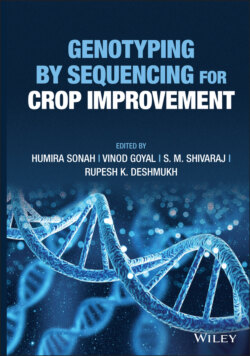Читать книгу Genotyping by Sequencing for Crop Improvement - Группа авторов - Страница 20
1.3.2.3 Randomly Amplified Polymorphic DNAs (RAPDs)
ОглавлениеWilliams et al. (1990) first developed these markers to amplify DNA without prior sequence information. In this type of marker, the arbitrary decamer sequences are used as primers at low annealing temperatures for DNA amplification. These markers are referred to as dominant markers because the polymorphism is determined based on the presence or absence of a particular amplified fragment. Polymorphism may also be due to varying brightness of bands at a particular locus due to copy number differences. These markers have been used for constructing linkage maps in several species (Hunt 1997; Laucou et al. 1998) and also for tagging genes of economic importance. However, due to the dominant nature, these may not be appropriate for genetic mapping and marker‐assisted selection (MAS). One major limitation of these markers is the lack of repeatability in certain cases. Variations of RAPD include AP‐PCR (arbitrarily primed PCR) and DAF (DNA amplification fingerprinting (Table 1.1).
Table 1.1 Details of the other important molecular markers.
| Marker | Description |
|---|---|
| Variable number tandem repeat (VNTR) or minisatellites | A short DNA sequence (10–100 bp) is present as tandem repeats and is a highly variable copy number |
| DNA amplification fingerprinting (DAF) | A variation of RAPD, where 4–5 bp single and arbitrary primer is used to detect polymorphism |
| Arbitrary‐primed PCR (AP‐PCR) | A variation of RAPD, where 18–32 bp long single and arbitrary primer is used to detect polymorphism |
| Inter‐simple sequence repeat (ISSR) | Primers are designed based on the repeat region of microsatellites. These primers are used to amplify the region between two microsatellites. The stretches of unique DNA in between or flanking the SSRs are amplified. A single SSR‐based primer is used to prime PCR |
| Selective amplification of microsatellite polymorphic loci (SAMPL) | A modification of ISSR, where SSR‐based primer is used along with AFLP primer. The template is identical to the AFLP template and the rare cutter primer is replaced by SSR‐based primer |
| Cleaved amplified polymorphic sequences (CAPS) | These markers are also called PCR‐RFLP, where amplified PCR product is digested with endonucleases to reveal polymorphism. These are used when PCR product does not show polymorphism and restriction enzyme site present in amplified PCR product may detect polymorphism |
| Derived cleaved amplified polymorphic sequences (dCAPS) | A variation of CAPS, where a primer containing one or more mismatches to template DNA is used to create a restriction enzyme recognition site in one allele but not in another due to the presence of SNP. Thus, obtained PCR product is subjected to restriction enzyme digestion to find the presence or absence of the SNP |
| Single‐strand conformational polymorphism (SSCP) | DNA fragments of size ranging from 200 to 800 bp were amplified by PCR using specific primers (20–25 bp), followed by gel‐electrophoresis of single‐strand DNA to detect nucleotide sequence variation. The method is based on a principle that the secondary structure of single‐strand DNA molecule changes significantly if it harbors mutation. This method detects nucleotide variation without sequencing a DNA sample |
| Denaturing/temperature gradient gel electrophoresis (DGGE, TGGE) | These methods reveal polymorphism due to differential movement of the same genomic double‐stranded region with different base‐pair composition. As an example, the AT‐rich region would have a lower melting temperature than the GC‐rich region |
| Target region amplification polymorphism (TRAP) | This method employs primers designed from the EST database for detecting polymorphism around a selected candidate gene. This includes two primers of 18 bp, one of which is designed from targeted EST and the other is an arbitrary primer |
